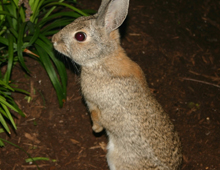Description: The Desert cottontail has a rounded tail with white fur on the underside. It is a light gray/brown in color, with creamy colored fur on the belly. It has long ears and large hind feet. They are like rodents in that their teeth grow throughout their life, thus necessitating constant chewing to keep them from growing too long.
Size: Adults are 12-17 inches (30 – 43 cm) long and weigh up to 3.3 pounds (1.5 kg). Females are larger than males.
Behavior: The Desert cottontail can usually be seen in the early morning or late afternoon and is rather inactive in the middle of the day, preferring to spend the hottest part of the day under cover. Desert cottontails may dig a shallow depression under a bush in which to rest, but they usually rest in the burrows of other animals. They are good swimmers and can run at speeds of up to 20 mph (32 kph).
Diet: They eat grasses, cacti, bark, twigs and shrubs (90% of their diet is grass).
Senses: Desert cottontails have good eyesight and hearing.
Communication: The Desert cottontail may stomp the ground with its hind foot or raise its short tail as a warning to others of possible danger.
Reproduction: Females usually have two to four litters a year (although some may have as many as six each year). The gestation period is 26-30 days. One to six babies are born in each litter. They are born naked and their eyes are closed. They leave the nest at two weeks of age and usually stay with their mother for three more weeks. Sexual maturity is reached at approximately three months of age.
Habitat/range: The range of the Desert cottontail is from southern California into the central United States, from eastern Montana to western Texas and into northern Mexico. It can be found in woodlands, grasslands, brush and desert areas.
Status: IUCN Least Concern.



